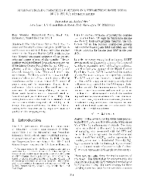
An official website of the United States government
Here’s how you know
Official websites use .gov
A .gov website belongs to an official government organization in the United States.
Secure .gov websites use HTTPS
A lock (
) or https:// means you’ve safely connected to the .gov website. Share sensitive information only on official, secure websites.
-
//
- Census.gov /
- Library /
- Census Working Papers /
- Alternate Scaling Parameter Functions in a Hierarchical Bayes Model
Alternate Scaling Parameter Functions in a Hierarchical Bayes Model
Alternate Scaling Parameter Functions in a Hierarchical Bayes Model
Abstract
The U.S. Census Bureau Small Area Income and Poverty Estimates program (SAIPE) currently uses an empirical Bayes estimation method similar to the Fay and Herriot (1979) model to produce biennial intercensal estimates of the poverty rates and counts of poor within counties. The dependent variable is formed from a three-year average of the March Current Population Survey (CPS) supplement, and the independent variables are formed from administrative data. The model includes two error terms. Problems with this estimation technique include a loss of data points due to the log transformation for counties whose CPS sample of poor is zero, and the requirement of using decennial census data to estimate the model error variance term. To address these problems, a hierarchical Bayes model based on a scaled binomial kernel has been developed (see Fisher and Asher (1999)). The scaling factor corrects for both the overdispersion of the variance and the complexity of the CPS sample design. This paper will discuss the effect of different scaling factor functions on the implementation and quality of this proposed model.
Share
Related Information
Some content on this site is available in several different electronic formats. Some of the files may require a plug-in or additional software to view.
 Yes
Yes
 No
NoComments or suggestions?


Top

